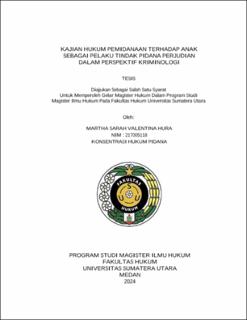| dc.description.abstract | Children are basically the buds, potential, and future generations of the nation's aspirations. In the juvenile justice system, a child in conflict with the law is a child who is aged 12 years or older but has not yet reached 18 years of age and is suspected of committing a crime. It is not uncommon to find children committing a crime; fundamentally, there are so many different forms of crimes that can be committed by children, one of which is gambling crime.
Research uses the type of normative juridical research through an empirical approach. In this research, it employs the statutory approach (statute approach) and the case approach (case approach). The data sources used are secondary data, consisting of primary, secondary, and tertiary legal materials. Data collection is conducted through library research and interviews, which are then processed and analyzed using qualitative analysis methods..
Sanctioning minors involves two dimensions: Diversi and Restorative Justice as stipulated in Articles 1 paragraph 6 and 7 of Law No. 11 Year 2012 concerning the Juvenile Justice System. Factors underlying juvenile gambling offenses include internal factors such as religious factors and factors of curiosity or desire to try, and external factors such as economic factors, environmental factors, family factors and educational factors. The judge's consideration in imposing sanctions on juvenile gambling offenders must be based on the principle of the best interests of the child as mandated in Law No. 11 Year 2012 concerning the Juvenile Justice System. From a criminological perspective, it is important to prevent minors from being labeled as gambling offenders, which can affect their life development. | en_US |


